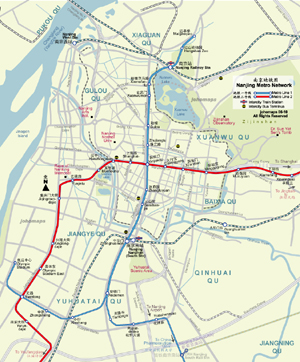|
Other names of Nanjing:
Nanking (Old Name), Jianye, Jiankang, Jinling (Historic
Names)
Adjective: Nanjing
Short form: Ning (宁)
Nanjing
(From Wikipedia)
Copyright owned by wikipedia.org
See
here for copyright and licensing conditions
Nanjing (Chinese: 南京;
Hanyu Pinyin: Nánjīng;
Wade-Giles: Nan-ching; Postal System Pinyin: Nanking), is the
capital of China's Jiangsu Province and a city with a prominent place in
Chinese history and culture. Nanjing has served as the capital of China
during several historical periods, and is listed as one of the Four
Great Ancient Capitals of China. Nanjing is also one of the fifteen
sub-provincial cities in China's administrative structure, enjoying
jurisdictional and economic autonomy only slightly less than that of a
province.
Located in the downstream Yangtze River
drainage basin and Yangtze River Delta economic zone, Nanjing has always
been one of China's most important cities. Apart from having been the
capital of China for six dynasties and of the Republic of China, Nanjing
has also served as a national hub of education, research, transportation
and tourism throughout history. It is also the second largest commercial
center in the East China region, behind only Shanghai.
History
Nanjing is one of the earliest established
cities in the southern China area. According to the legend, Fu Chai, the
Lord of the State of Wu, founded the first city, Yecheng (冶城)
in today's Nanjing area in 495 BC. Later in 473 BC, The State of Yue
conquered Wu and constructed the city of Yuecheng (越城) on
the outskirt of the present day Zhonghua Gate. In 333 BC, after
eliminating the State of Yue, the State of Chu built Jinling Yi (金陵邑)
in the northwestern part of the present day Nanjing. Since then, the
city has experienced numerous destructions and reconstructions.
Nanjing first became a capital in 229 AD, where
Sun Quan of the Wu Kingdom during the Three Kingdoms Period relocated
its capital to Jianye (建邺), a city he extended on the
basis of Jinling Yi in 211 AD. After the invasion of the Five Hu, the
nobles and wealthies of Jin Dynasty escaped across the Yangtze River and
established Nanjing as the capital, which was then called Jiankang (建康).
Since then Jiankang remained as the capital of Southern China during the
North-South Division period, until Sui Dynasty reunified China and
destroyed the entire city, turning it into farmland.
The city was reconstructed during late Tang
Dynasty and was again made the capital by the short-lived Southern Tang
Kingdom (937 ?975). Jiankang's industry burgeoned and thrived during
Song Dynasty, although it was constantly under threat from the northern
foreign invasion. The Mongolians, after taking over China, further
consolidated the city's status as a hub of the textile industry.
After successfully emerging as the winner
during the warlords division period at the end of Yuan Dynasty, Zhu
Yuanzhang, the founding emperor of Ming Dynasty, established the city
again as the capital of China in 1368, for the first time adopting the
modern name, Nanjing, for the city. He constructed what was the largest
city in the world during that time, and it took 200,000 laborers 21
years to finish the project. The present day city wall of Nanjing was
mainly built during that time, and it is the longest surviving city wall
in the world.
It is believed that Nanjing was the largest
city in the world from 1358 to 1425 with a population of 487,000 in 1400.
During the Qing Dynasty (1644-1911), the
Nanjing area was known as Jiangning (江宁) and served as the
seat of government for the Liangjiang Viceroy. Nanjing was the capital
of the Taiping Kingdom in the mid-19th century, being renamed as
Tianjing (天京) (lit. Heaven's Capital). As Qing
general Zeng Guofan retook the city in 1864, massive slaughtering
occurred in the city with over 100,000 committing suicide or fighting to
the death.
In 1912, Dr. Sun Yat-sen led a successful
democratic revolution to overthrow Qing Dynasty and founded the Republic
of China, making Nanjing its capital. The capital was later moved to
Beijing after Yuan Shi-kai taking over the presidency. Yet in 1928, the
Kuomintang (KMT) under Chiang Kai-Shek again established Nanjing as the
capital of China (Republic of China), as opposed to a government in
Beijing led by northern warlords and an alternate government in Wuhan
led by Wang Jingwei.
In 1937, the Japanese army invaded and occupied
Nanjing, which was then the capital of China. It is recognized that a
systematic, brutal massacre was carried out by the occupying force in
the city, with the estimated death of 300,000. A puppet government led
by Wang Jingwei was established in Nanjing, and after World War II, the
KMT relocated its central government to Nanjing. On April 23, 1949, The
People's Liberation Army conquered Nanjing, officially ending the
Republic of China's rule in the mainland. Today, Nanjing remains the
provincial capital of Jiangsu.
|

